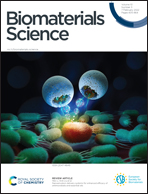Ultrasound-activable piezoelectric membranes for accelerating wound healing†
Abstract
Ultrasonic energy harvesting technologies have gained much attention for biomedical applications due to their several desirable features including low-energy attenuation and strong penetration capability. In this work, flexible piezoelectric poly(vinylidenefluoride-co-trifluoroethylene) (P(VDF–TrFE))/barium titanate (BaTiO3, BT) membranes, capable of converting ultrasound energy to electric energy, were fabricated by an electrospinning process and their effects on the wound healing behaviors with/without ultrasonic stimulation were investigated. The piezoelectric membranes showed excellent electric outputs and can be used as a sustainable power source to quickly charge LEDs and capacitors. The penetration capability of ultrasound waves was investigated by implanting the membranes at different depths of porcine tissue. The membrane was able to generate a high voltage of 8.22 V even at a depth of 4.5 cm. Furthermore, ultrasonic stimulation on the piezoelectric membranes facilitated the proliferation and migration of the fibroblasts, and a cell migration rate of 92.6% was obtained after 24 h in the cell migration test. Under ultrasonic vibration, the electric field generated from the membranes accelerated the wound closure rate in an animal wound model. These results demonstrated the effectiveness of the flexible piezoelectric membranes in stimulating cellular behaviors, which may provide a new therapeutic strategy for wound care.



 Please wait while we load your content...
Please wait while we load your content...